4 Things to Consider When Embracing a “New Normal”
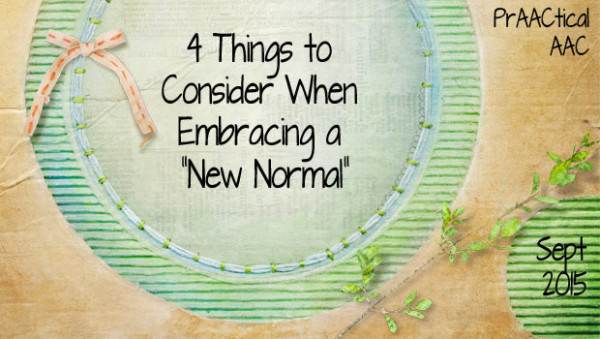
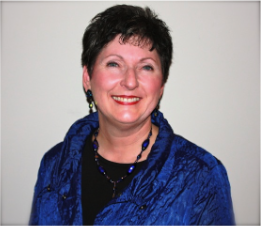 It isn’t every day that we get to hear from AAC interventionists who’ve been doing this work for decades. Today, we are thrilled to welcome back SLP Marlene Cummings from Oakland Schools in Michigan. Marlene has written several very popular posts on AAC in educational settings. (Click here to peruse them.) In this post, Marlene gets us thinking about ways to deal with change in a positive and sustainable fashion. Her passion for supporting both kids and colleagues is infectious. Enjoy!
It isn’t every day that we get to hear from AAC interventionists who’ve been doing this work for decades. Today, we are thrilled to welcome back SLP Marlene Cummings from Oakland Schools in Michigan. Marlene has written several very popular posts on AAC in educational settings. (Click here to peruse them.) In this post, Marlene gets us thinking about ways to deal with change in a positive and sustainable fashion. Her passion for supporting both kids and colleagues is infectious. Enjoy!
::::::::::::::::::::::::::::::::::::::::::::::::::::::::::::::::::::::::::::::::
I have the privilege, as part of a 5 member AAC Team, of supporting 28 school districts with more than 100 teams serving students with complex communication needs using AAC. The staff members and teams we support come with varied levels of knowledge, diverse experiences, and degrees of confidence.
For us the new school year is just around the corner. We are already receiving calls and emails reporting changes in caseloads, classrooms, staff, and roles. Change is inevitable. Change, even good change, is hard. It demands that we embrace a “new normal”. Sometimes this is a choice other times not so much.
4 Things to Consider When Embracing a “New Normal”
- Beliefs and the power they carry
- Encouragement; to you and from you
- What’s in your Toolbox?
- Find your Tribe
The beginning of a school year poses its own challenges; now add to this unexpected or unwanted change. Sound familiar?
You are starting a new school year. You get your caseload. You look through your list…yep, yep, yep…WAIT…who is this student? You go and get the file. It only takes you a moment to realize this student needs AAC supports. Now what?
Some of you are jumping for joy and can’t wait to dig in. Many more are instantly feeling a heightened level of anxiety and wondering if you can give the case to someone else, or how high will your learning curve have to go? You think: “This is only the beginning of the year, and this is only one of my students!” Sometimes it is hard to remember that “everyone” didn’t wake up in the morning determining to ruin your day or year. Then again, you wonderJ.
You get a call from your supervisor adding a new student to your caseload. You have heard rumors about the complexity of the case and already you are sure everything is going downhill from here. The fact they are only rumors doesn’t seem to help.
You instantly feel yourself losing the excitement of starting a new year. Where did all those amazing plans go?
Can you identify? There are so many different ways you are being impacted by change. One thing we know about human nature is when we are under stress we typically default to skills we do automatically. You hear athletes and emergency personnel report they “let their training take over”. We tend to revert back to “familiar” rather than embrace the new, which isn’t comfortable or familiar yet. This is not always helpful.
I remember starting a new job that tapped my current skills but also demanded I develop my untapped skills and pull on my strengths to an even greater degree. I said to my boss one day, “I remember a time when I had skills, I just can’t figure out where they are hiding right now”.
It takes intentionality, reflection and awareness to embrace our “new normal”. Especially when this involves increasing our knowledge, applying our skills differently and doing it all at a faster pace, with new people, in new environments, and with new expectations.
# 1 Our beliefs carry more power than we realize. Let’s consider their impact. As team leaders and team members we are participants in a dynamic learning collaboration. This is not always an easy place to be. There are often barriers, which slow down or impede the team’s forward motion.
Statements declared or unspoken by our team members are often the elephant in the room. Here are just a few…
I can’t do this…I don’t have time…I don’t have the knowledge… it’s too hard… I will fail…I am overwhelmed…this is daunting…I can’t do this alone…if only XXXX would do their part.
“I don’t know where to start!?” is the one we hear most often. As Speech/Language Pathologists, we are the “go to” person on the team for everything “communication and language”. It does not feel comfortable to have an area in our field of practice that we don’t have a solid set of strategies to draw from. In fact it feels downright “unnerving”. Most team members could say the same thing in their area of expertise. Does that possibly mean we aren’t alone in this? Yep, that’s exactly what it means. Who else is feeling the same way right now?
Whether you are hearing these statements or saying them to yourself, it is clear that what you believe is now filling your thoughts and impacting your feelings. Your actions are the result.
I have condensed this thinking into four statements that I keep visible in my environment to remind me to ask the question: “what am I believing right now?” Are my actions and feelings lining up with my beliefs or am I believing a lie. I say I am a lifelong learner, but what happens when I find myself lacking in knowledge about a topic or a strategy? Do I begin to dig into it, not being ashamed that I don’t know, or do I panic and get defensive because I feel foolish not knowing? Hmm! Good question?
Our BELIEFS become our THOUGHTS.
Our THOUGHTS become our FEELINGS.
Our FEELINGS become our ACTIONS.
Our ACTIONS are what others SEE or what we DO.
We know from experience that what we believe about ourselves influences how we show up, which in turn impacts how others perceive us. What are we modeling for others? With all the technological advances I often hear: “It is more important to know where to find the answers than to have them memorized”. Then why do we feel so challenged when we don’t know the answer immediately? Just wondering? Knowing where to find the answer is key!
If someone else believes I can do something does that change how I view myself? Yes it does. My husband believed that I could rock climb, sea kayak and go caving. I had no experience with any of these things. Guess what? I have and loved every minute. Well, when I had hundreds of bats flying at me, love may not be the word I would use. Agree with people who believe in you.
One definition of belief is “a mindset or overriding premise.” What is your mindset?
Think about your students for a minute. What do you believe about them?
- Are your students learners?
- Will they develop language in time?
- Will their understanding of language & language skills continue to grow?
- Will they know if we don’t believe in them and their abilities? What if we do believe? Will they know that too?
I bet you have heard the phrase “assumed or presumed” competence? It’s showing up a lot right now. We asked several professionals what they believed presumed competence might look like?
- They are communicators
- They are learning
- Their success is inevitable
- They will accomplish the task
- They will develop the skill
- They will meet their goals
- They have cognitive abilities and they are being applied to this instruction
- They are beginning to make sense of print and it’s meaning
- They are aware and learning even if it does not look like it to you
Ask this question at your next staff meeting or gathering. I would love to hear your results. Did it change your thinking? Did it give you a new perspective?
What to ponder: What do you believe and how does that match what you are “doing” everyday? You may find it will uncover some lies you believe about yourself or others.
# 2 Encouragement is greatly needed, but highly underutilized.
We use the word daily. Let’s define it.
- The action of giving someone support, confidence, or hope
- The act of trying to stimulate the development of an activity, state, or belief
- Persuasion to do or to continue something
In the midst of writing about encouragement I had the opportunity to experience it first hand. A team member and I were getting coffee in the lunchroom. Doesn’t everyone need caffeine half way through the day? A colleague came in and graciously complemented me. We returned the gesture. Positive comments flowed for the next minute or so. The coffee was done and out we went. As I walked back to my office I felt different. Those unsolicited words had changed the very atmosphere around me. Is that what a simple yet heart felt compliment could do? Yes it is.
A question was asked of a group of professionals whose goal is to approach their life in the workplace with intention and excellence. “What would you like to take away from this initiative?” I have to say I was a bit surprised at the resounding response. “I/we need encouragement.” We broke into groups to determine what that might look like. Here are some of their responses. Do any of them resonate with you? What would your list look like? Wouldn’t this be an interesting activity for your team? It only takes a few minutes, but could profoundly impact how you interact and support one another.
How you might encourage others:
- Point out their qualities and strengths
- Listen to them
- Send notes, texts and messages on social media
- Encourage them with truth in love
- Confirm who they are, not the struggle they are having
- Share your breakthroughs
- Keep your promises
- Be kind, even under pressure
- Celebrate others life events
- Be thankful
- Build relationship, even when you don’t feel like you have the time
How to encourage ourselves:
- Spend time with others of like mind (“your tribe”)
- Worry less
- Do things you love (walk, paint, read)
- Be thankful
- Share your needs with others
- Be kind to yourself
- Laugh more
- Learn new things
- Remember your accomplishments
- Revisit compliments, encouraging notes, awesome gifts
- Be intentional
Sounds simple doesn’t it? You might even be saying, “I already do this…how can this make a difference with my challenges?…I need content…I need the how to…I need answers.”
A recent experience drove this point home. While instructing students in a camp environment, and not feeling especially confident in the moment, my teaching partner receives “that” email. The one informing her she would have more students than expected with more complex needs than expected. You know the one. I quickly stepped into my “encouragement mode”. I had been there before and knew the thoughts and feelings flying through her brain right then. She stepped out to make the call. Little did I know our brief conversation was overhead by a colleague who then thanked me for my support. I was now on the receiving end of an encouraging word. Do you see how that happens? Now, those exchanges did not give me the content specific answers I needed. They did however realign my thinking and my feelings in a productive direction.
Each of you can give examples of times you have been an encouragement or been encouraged. What if you were less random and more intentional? What if you picked 1 or 2 people a week to encourage and added one thing a week that you know would be an encouragement to you? What if you had a list of ways to encourage your team members and they knew how to encourage you. Simple? Yes! Doable? Yes! Impactful? Beyond measure!
What to ponder: How often do you get encouraged and from who? How often do you encourage others? Do you know the best ways to encourage your team members, students, friends and family? How might you find that out?
# 3 What would a toolbox look like that was filled with specialty tools representing your knowledge, innate strengths and personal experiences.
Several years ago I met with a group of SLP’s looking for AAC supports for some of their students. They were slightly familiar with AAC and less familiar with AAC devices and technology. I was trying to find a good starting place without giving them an AAC 101 college course. It was not going well. I stopped trying to share all the “new” in AAC and began discussing ways to use the AAC systems in the classroom. Within minutes of mentioning some classroom activities, it was apparent I had lost them. Finally a brave soul declared, “What does this have to do with AAC? I already know how to teach language.” Ahha! There it was. I had finally hit on the “known” so I could connect it to the “new” or “unknown”. SLP’s know language. What do you already know?
I had tapped into the “known” for them. When teaching vocabulary we use known words to teach new words. When teaching a new skill we look for what we already know to use as a platform to learn the new.
You have been learning your whole life. But do you actively draw upon your present knowledge to leverage your new learning? I know I don’t. Especially when I am stressed, anxious or pressed for time. Years ago we had a medical emergency in my classroom. As my assistant was preparing to call 911, she turned and asked what the # was. She knew the # and it was written on the front of the emergency card she was holding. As soon as she asked the answer came to her and she dialed it. This happens more than we think and not always under such obviously intense circumstances. Do not hesitate to step back and consider what you already know and how it can support your present learning.
Often we don’t even know what our strengths are because they are so familiar. They are things we just ‘do”. It is important to be able to identify who we are, what we are good at and what we know. Then, when the challenges, stressors, or change comes we know what tools are in our toolbox, which one to use and how to use it.
I have had many opportunities over the years to help people discover more about themselves and explore their career path. One of the tools I use is Strengths Finder 2.0. After reading the book and taking an online test it identifies your top 5 strengths. This is just one of many tools that help in this exploration. I took the test years after choosing and working in my profession. The results were not a surprise but a confirmation. It has given me language and a grid to better articulate who I am, not just what I do.
What to ponder: What is in your toolbox? What are your strengths? What is your knowledge base? What experiences do you have to draw from? Who and what would help you find these answers?
#4 What if you had a Tribe of like-minded colleagues who passionately pursued “everything AAC” just the way you do.
We as humans want and need community. We are designed to do life together. When we connect ourselves to those who resonate with us around a common language, our passion or vision, it becomes synergistic. The definition of synergy says it all: two or more things (or people) working together in order to create something that is bigger or greater then the sum of their individual efforts.
Greatness occurs when we can learn new content, develop new strategies, and hone our skills within a dynamic team filled with passion, vision, like-mindedness and intentionality.
We know that many team members supporting students needing AAC are the lone representatives in their field as well as one of very few carrying the passion for these students. Finding your “tribe” is not always an easy task. But it is worth it!
There are a myriad of collaborative learning models. In our attempt to create a “tribe” we have or are exploring Professional Learning Communities, Professional Book Clubs, and a Community of Practice model. These can happen face to face or virtually.
Are the participants finding their “tribe”? They say YES! They have shared some of the things they love when they congregate:
- Sharing with others successes and challenges
- Colleagues sharing their successes and challenges
- Experts and researchers delivering timely content
- Being able to ask questions after we have tried a few things
- Examples of materials and activities that are working
Whatever your preference, whoever is in your area, seek them out. Not finding one? Create one. It is worth the time and energy.
We need community. It takes more time and you have to be intentional to get involved, to stay the course, but in the end as the commercial says: it is priceless. Go out and find your tribe.
What to ponder: How would you describe “your tribe”. How will you find them? How will you build sustainable collaborative relationships?
Let’s remember:
4 Things to Consider When Embracing a “New Normal”
- Beliefs and the power they carry
- Encouragement; to you and from you
- What’s in your Toolbox?
- Find your Tribe
I can’t think of a more amazing time in history to be able to passionately serve students with complex communication needs. Thanks for joining the tribe on this remarkable journey.
Filed under: PrAACtical Thinking
Tagged With: collaboration, community, Marlene Cummings, schools, Team work
This post was written by Carole Zangari

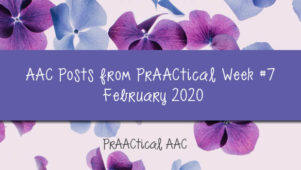
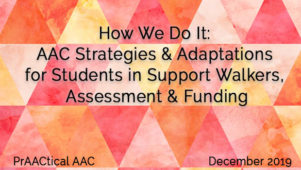
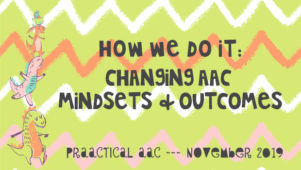
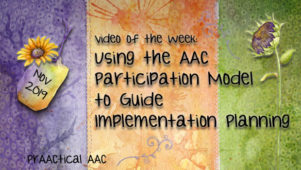
2 Comments
Dear Carole.
Thank you very much for your extensive thoughts on the topic. I was fortunate to have come across your article on 4 things to consider in embracing the New Norma. I think I too, need to move on because I myself still hoping for the old normal. Thanks for the beautiful new normal thoughts and reflections. I was triggered by your terms but when I read it, I was so surprised and thought that it is now the new normal creativity. of terms. I am Sr. Cleopatra Moreno,OP, School Head/Principal of a School for Girls in one the remote and place in our country.
Hello Sr. Cleopatra Moreno,
Thank you so much for your thought reflection on this post. New normal seems to be something all of us are grappling with more often than we ever imagined.